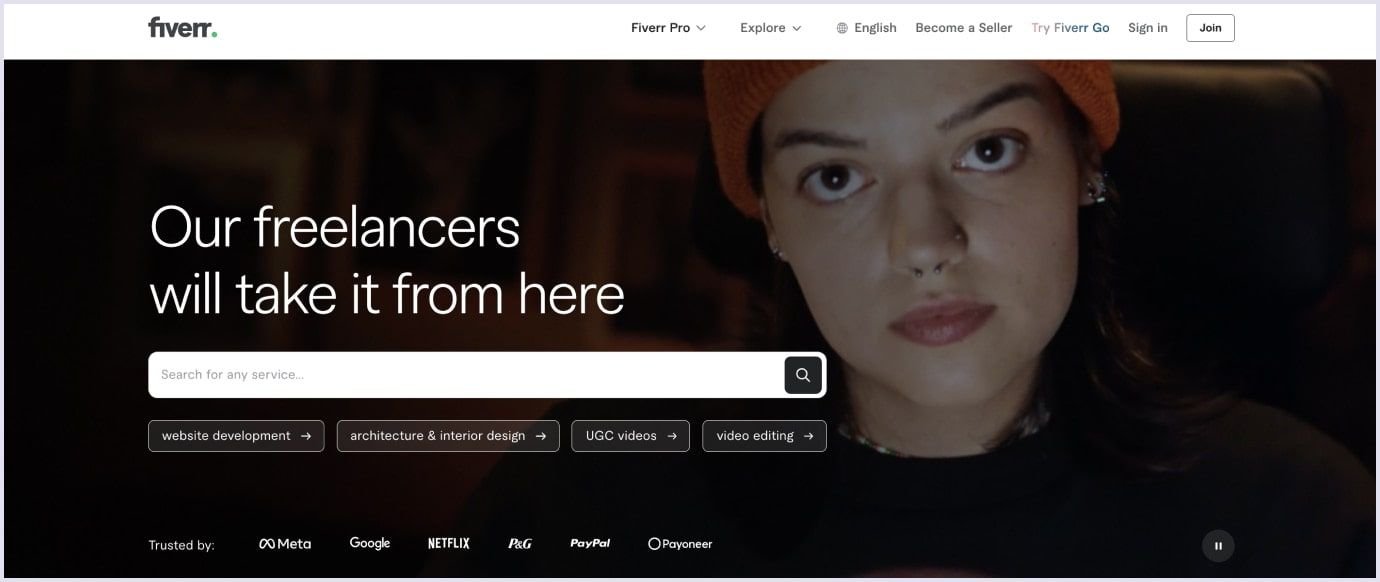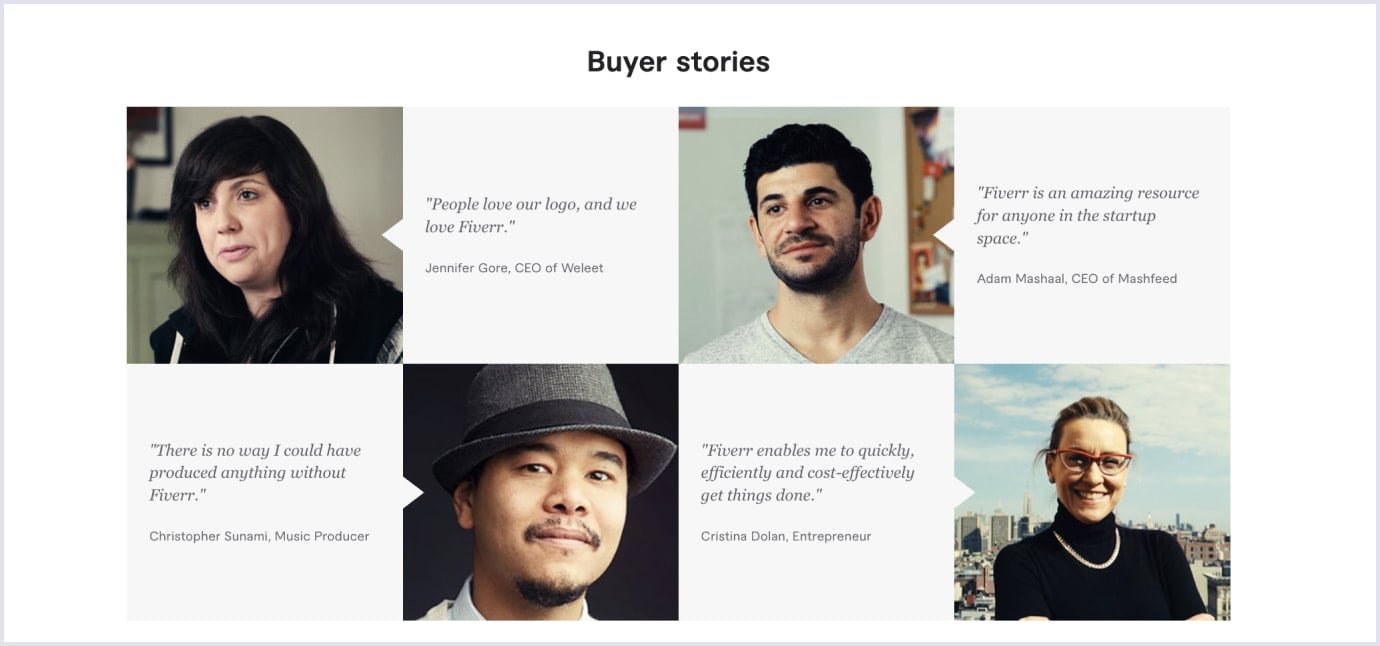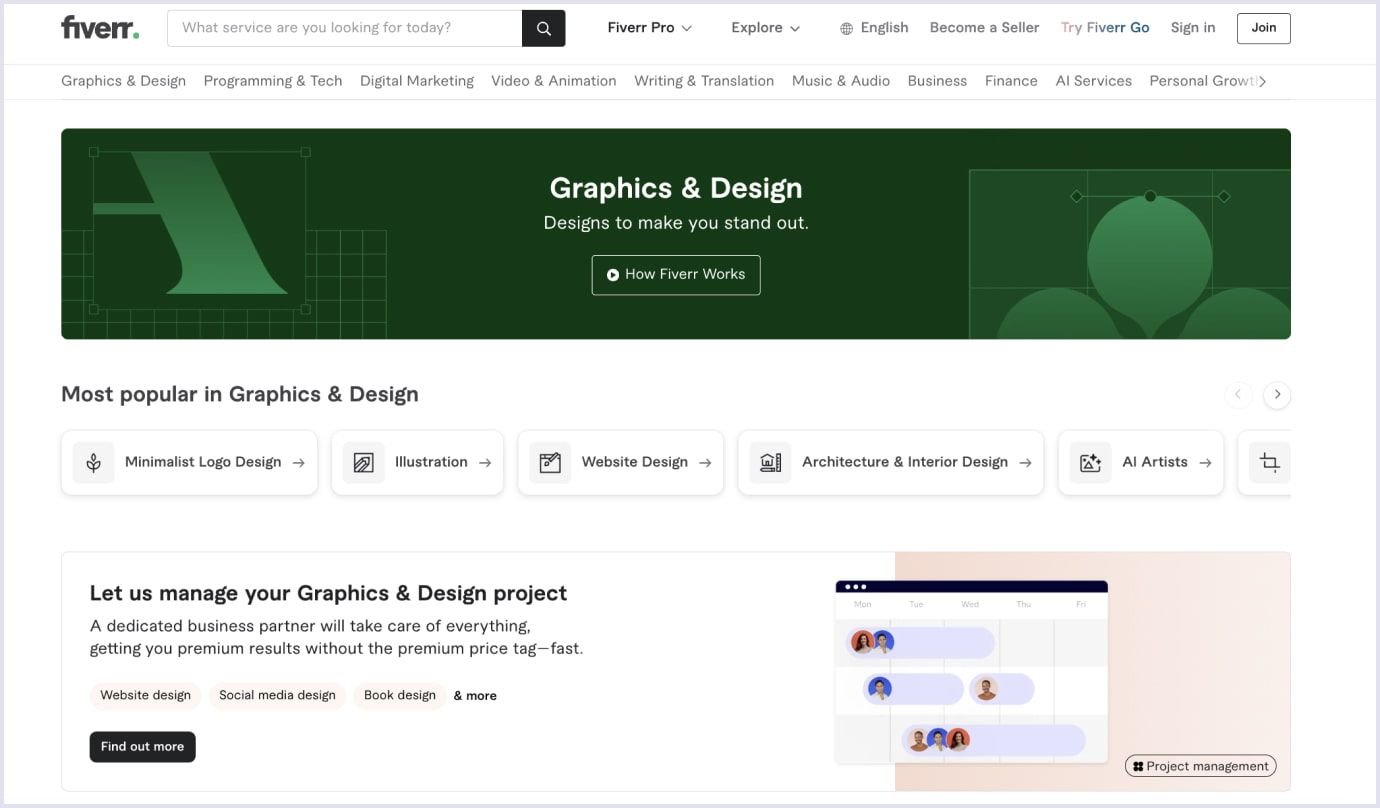At first glance, platforms like Fiverr make it look effortless: small tasks, fixed rates, quick turnarounds. But under the hood, there’s a powerful, flexible system built to handle millions of users and transactions globally.
Thinking of launching something similar? This guide breaks down everything you need: essential features, technology stack, cost estimates, and a clear development roadmap to bring your micro-job marketplace to life.
What’s a micro-job platform?
It’s an online space where independent professionals offer compact, well-defined services, often referred to as "gigs”, for set prices.
Unlike conventional freelance platforms that involve lengthy proposals, negotiations, and detailed project briefs, micro-job marketplaces simplify the process by presenting services as standardized, ready-to-purchase offerings.
Core traits of this model typically include:
- Service packages instead of custom quotes or bids;
- Clear pricing tiers like Basic, Standard, and Premium;
- Fast turnaround times, usually ranging from one to seven days;
- Built-in tools for messaging, order management, and secure payments;
- A smooth, no-hassle buying experience, much like shopping on an ecommerce site.
This streamlined format lets clients quickly find, compare, and order the services they need, no contracts, no drawn-out conversations, and no ambiguity.
To give you an idea, here are a few common examples of micro-jobs:
- Designing eye-catching social media graphics;
- Writing product descriptions with SEO in mind;
- Producing a polished voiceover for a podcast intro;
- Building a custom WordPress landing page;
- Translating short-form content with cultural nuance.
For clients, the appeal lies in speed and simplicity. For freelancers, it offers a repeatable, flexible way to earn from niche skills without the overhead of traditional freelancing.
Freelance, global, and built to scale: Why this model keeps winning in 2025
Freelance work it’s how a big part of the world gets things done. In 2025, platforms like Fiverr, Upwork, and smaller niche micro-job marketplaces are playing a real role in everyday business. They’ve become a real part of the global work infrastructure.

Source: Fiverr
Fiverr’s revenue in Q4 2024 reached $103.7 million, up from $91.5 million in Q4 2023, a 13.3% year-over-year increase. This consistent growth proves that quick, packaged freelance services are still in high demand, and there’s plenty of space for smaller, niche or local platforms to step in and succeed.
Let’s explore why the micro-job model keeps growing, and why now is a smart time to get in.
Global talent, global demand
Remote work is the new normal. Companies everywhere are used to hiring freelancers across countries and time zones. Micro-job platforms make this even easier by letting businesses find, book, and pay freelancers in just a few clicks, whether you're a startup in Berlin or a content creator in Manila.
Speed matters more than ever
Businesses now need things done quickly. Long hiring processes just don’t work anymore. The micro-job model offers fast, on-demand services without contracts, back-and-forth emails, or delays, which is exactly what clients want.
Prepackaged services are easier to grow
Micro-jobs are structured like products, with clear pricing, scope, and delivery. This allows freelancers to work more efficiently, serve more clients, and deliver consistent quality. For platform owners, it also means fewer support issues, more predictability, and smoother scaling.
AI is changing what freelancers offer
Many freelancers now sell services like “AI-enhanced content,” “prompt engineering,” or “AI art generation.” Micro-job platforms can adapt quickly to these new service types, while traditional agencies often lag behind.
Must-have features for buyers, sellers, and admins
What sets platforms like Fiverr apart isn’t just the variety of gigs. It’s how well the whole system works for everyone involved: freelancers, clients, and platform managers.
If you want your micro-job marketplace to compete, certain tools are non-negotiable.
For sellers (freelancers)
Freelancers are the lifeblood of your platform. Empowering them with intuitive, flexible tools increases retention and service quality.

Source: Fiverr
Must-have features:
- Gig builder. An intuitive interface where sellers can easily define their service, set package tiers, pricing, timelines, and upload media or FAQs.
- Package options. Allow sellers to offer structured choices like Basic, Standard, and Premium with clear value at each level.
- Seller dashboard. Centralized control panel to track ongoing work, earnings, reviews, and delivery timelines.
- Order tools. Options to accept or decline orders, communicate with buyers, manage file deliveries, and request more info if needed.
- Fast payouts. Seamless integrations with payment platforms (e.g., PayPal, Payoneer, Stripe) for easy withdrawals.
- Flexibility on edits and deadlines. Tools to handle revisions, extend delivery time, or manage cancellations smoothly.
- Mobile-ready interface. A responsive design that supports freelancers who prefer working from their phones (which is the majority).
For buyers (clients)
Buyers want confidence, speed, and results. A frictionless discovery and ordering experience is what converts visits into transactions.

Source: Fiverr
Must-have features:
- Smart search and filters. Let buyers narrow results by budget, timeframe, ratings, or even language spoken.
- Gig details page. Full transparency: service breakdowns, seller videos, customer reviews, and samples of past work.
- Streamlined checkout. Let users place orders quickly, with optional extras or upgrades.
- Built-in chat. Safe messaging before and after purchase to clarify expectations.
- Progress updates. Real-time order status and estimated delivery timelines.
- Secure payment system. Escrow-style processing to protect both sides, with refund capability when needed.
- Ratings and reviews. A clean feedback system that helps future buyers make informed choices while keeping things fair.
For platform admins
Admins manage the engine. Your backend should empower them to moderate fairly, act quickly, and evolve intelligently.
Must-have features:
- Moderation controls. Approve or remove users and gigs, resolve disputes, investigate abuse.
- Flexible commission settings. Configure fees based on categories, seller tiers, or other criteria.
- Content management system (CMS). Update FAQs, blog content, landing pages without dev help.
- Analytics dashboard. Track revenue, user retention, transaction volume, and top sellers.
- Dispute resolution tools. View full order history, messages, attachments, and enforce outcomes.
- Notification and email controls. Custom templates for system alerts, user actions, and marketing emails.
- KYC/verification module. Optional onboarding checks for seller credibility (especially in B2B or premium niches).
Your UX should always keep each role focused on one goal. Freelancers: complete more orders, buyers: find the right gig quickly, admins: keep the engine running cleanly.

Source: Fiverr
Read also: Marketplace Design: Why UI/UX Matters
Your step-by-step guide to building a micro-job marketplace
You’ve got the idea. You’ve studied the market. Now, how do you actually build a platform that delivers real value and competes with established players?
At Codica, we’ve spent over a decade helping startups and companies bring marketplace ideas to life. Below is a proven 6-step process we follow to create scalable, intuitive, and business-ready platforms, including those inspired by the Fiverr model.
Step 1: Project discovery phase: Define what you're building
Every successful platform starts with clarity: project discovery phase. In this initial phase, we work with you to define your business goals, target audience, core functionality, and success metrics. This is where our product discovery services come into play.
We identify key features, user flows, monetization logic, and even possible growth bottlenecks, long before a single line of code is written.
A well-run discovery process helps reduce development risks and avoid costly rework later. A detailed discovery phase can reduce total development time by up to 30%.
Step 2: UI/UX design services: Build for humans, not just screens
Your platform’s design is not just about looking good, it’s about converting visitors into buyers and freelancers into active sellers.
With our expert UI/UX design services, we craft interfaces that feel effortless and familiar while being uniquely yours.
In marketplaces, intuitive navigation, micro-interactions, mobile responsiveness, and trust-building UX elements are crucial.
Think: seamless gig previews, clean dashboards, smooth checkout flows, consistent branding, from logo design to interface components, all designed to reduce friction and increase conversion rates.
Step 3: Custom software development: Build a strong, scalable core
With designs in place, it’s time to bring your platform to life. Our developers begin coding the core functionality: gig creation tools, buyer search filters, real-time chat, dashboards, payment integrations, and admin controls.
At Codica, we use modern, battle-tested technologies to ensure your platform is fast, secure, and scalable. Whether you're building from scratch or integrating third-party services, our custom software development approach keeps your product lean and high-performing.
We always build with future scaling in mind, because your first 100 users shouldn’t feel different from your first 10,000.
Step 4: Integrate smart features: AI services where they matter
Want to go beyond the basics? This is where AI services can give your platform a competitive edge. You can integrate features like:
- AI-powered gig recommendations;
- Smart search suggestions;
- Fraud detection algorithms;
- Language translation;
- AI-assisted gig descriptions or tags.
These aren’t just “nice-to-have”, they can dramatically improve user retention and engagement by making the platform feel smarter and more responsive.
Step 5: Quality assurance services: Test like it’s launch day
A great product is only great if it actually works. That’s why every build at Codica goes through rigorous quality assurance services.
We test every user flow: registration, ordering, payments, messaging, cancellations, reviews, across browsers, devices, and edge cases. We simulate real-world user behavior to catch bugs before your users do.
A single broken checkout flow can cost you hundreds of users. QA ensures it never happens.
Step 6: Launch, learn, and improve
Once your MVP is tested and ready, we help you go live. But that’s not the end, it’s the beginning. At Codica, we stay with you post-launch to monitor usage, gather feedback, and ship improvements.
Whether it’s optimizing the search UX, introducing new monetization options, or helping you scale globally, we’re your long-term partner.
MVP or full product: What should you build first?
Trying to build a “perfect” product from day one is a common trap. A smarter approach is to launch with an MVP product. Something simple, functional, and fast. It lets you see what people actually want and saves you time, effort, and budget early on.
An MVP should focus only on the core user journey, helping buyers find services and sellers deliver them smoothly. At this stage, simplicity is a strength.
Here’s what your MVP should absolutely include:
- Account creation (for buyers and sellers);
- Posting and viewing gigs;
- Basic search and filtering;
- Placing and processing orders;
- Direct chat between users;
- Admin access to manage content.
As your platform gains traction, you’ll start to notice patterns: users logging in more often, giving feedback, and asking for new tools. That’s your cue. When people rely on your platform and want more from it, it’s time to evolve beyond the MVP.
You might expand by improving analytics, launching mobile apps, or introducing niche-specific features. The MVP shows you what works, the full product builds on it.
Mobile comes first: Don’t ignore it
Most users will access your platform from their phones, whether they’re browsing gigs during a break or managing orders on the move. If the mobile experience is slow or awkward, many won’t come back.
That’s why it’s important to think about mobile early on, from responsive design to dedicated mobile app development services that ensure everything works smoothly on smaller screens. A strong mobile experience helps users stay active and makes everyday actions like messaging or placing orders feel effortless.
How to monetize your micro-job platform: 3 proven models
A great platform solves real problems, but a successful one also generates steady, predictable revenue. When building a Fiverr-style micro-job marketplace, you need to think beyond the technology and into the business engine powering it.
Here are three proven monetization models that platforms like Fiverr, Upwork, and niche marketplaces around the world use to grow revenue while maintaining user trust.
1. Commission on transactions (Fiverr’s core model)
This is the most common and scalable model, and for good reason. Each time a seller completes a gig, the platform takes a percentage of the transaction.
- How it works. If a freelancer charges $100 for a logo design, your platform may keep 10–20% as a fee.
- Why it works. It aligns with platform success — the more orders completed, the more revenue you earn.
- Tips to scale. Introduce tiered commission rates based on seller level or category, or reduce fees as an incentive for early adoption.
Fiverr charges sellers a flat 20% per order, generating hundreds of millions annually from this alone.
2. Subscription plans for sellers or buyers
Another popular model is offering premium features through monthly or annual subscriptions, ideal for power users on both sides of the platform.
- For sellers. Boosted gig visibility, advanced analytics, early access to leads, or lower commissions.
- For buyers (especially B2B). Dedicated support, project management tools, and custom gig workflows.
You can build this into your platform during development or add it later.
3. Paid promotion & featured listings
When your marketplace starts to grow, sellers will want to stand out. This opens the door for advertising-based monetization, including:
- Featured gig placements on the homepage or top of search results.
- Sponsored categories or promoted sellers.
- “Urgent” or “Express” tags available for purchase.
This model works especially well on platforms with high competition and a large buyer base. You can combine featured listings with performance metrics (e.g., only allow 5-star sellers to promote) to maintain trust.
How much does it cost to build a micro-job marketplace like Fiverr?
Creating a Fiverr-style platform requires thoughtful planning, both technically and financially. Below is an estimated breakdown of development time and cost based on a $50/hour rate, typical for Eastern European development teams.
| Expected cost to make an online freelance marketplace | ||
| Features | Time, hours | Cost ($50/h) |
| Design | ||
| UX development | 64 | $3,200 |
| UI development | 96 | $4,800 |
| Architecture | ||
| Project setup | 16 | $800 |
| DB structure | 32 | $1,600 |
| Integrations | ||
| Payment (Stripe or PayPal) | 64 | $3,200 |
| Main functionality | ||
| Authorization and security | 72 | $3,600 |
| Account settings | 40 | $2,000 |
| Homepage | 56 | $2,800 |
| Search and filters | 96 | $4,800 |
| Contractor page | 80 | $4,000 |
| Reviews and ratings | 54 | $2,700 |
| Chat | 48 | $2,400 |
| Gig package form | 32 | $1,600 |
| Project dashboard | 48 | $2,400 |
| Ad posting form | 54 | $2,700 |
| Notifications | 32 | $1,600 |
| Business panel | 96 | $4,800 |
| Contractors panel | 104 | $5,200 |
| Admin panel | 120 | $6,000 |
| Non-development activity | ||
| Project management | 64 | $3,200 |
| Quality assurance | 80 | $4,000 |
| Code review | 32 | $1,600 |
| Total | 1380 | $69,000 |
However, the final cost will depend on your development partner's rates and the functionality you choose to include.
Besides, you should analyze much more information to know precisely how much it costs to run a website like Fiverr. For example, this includes platform maintenance and support, hosting, ads, etc. Thus, the price we provide is an estimated price specifically for building a platform.
Why Codica is the right partner for your micro-job marketplace
Launching a micro-job platform is about designing a scalable, intuitive, and profitable product from the ground up. To do that, you need a team that understands marketplace dynamics, modern product architecture, and what it takes to deliver consistent value for both buyers and sellers.
At Codica, we build sophisticated marketplaces that are easy to use, fast to scale, and designed with business success in mind.
10 years of experience
With over a decade in the industry, we’ve built a wide range of marketplaces, from job boards and multi-vendor platforms to niche vertical products. Our team knows how to avoid common pitfalls and build solutions that are both technically sound and commercially viable.
100+ successful projects
We don’t just build platforms, we help clients launch and grow businesses. One of the examples is the Tradeaboat project, an online marketplace for selling and buying boats in Australia.
Tradeaboat came to us with a clear goal: to modernize their platform, increase private listings, improve UX, and maintain integrations with third-party systems like CDS. Our team delivered a fast, mobile-friendly, PWA-powered platform that dramatically improved SEO, user engagement, and listing volume.
During the work on the project, Codica’s experts showed great communication skills and a high level of professionalism. They performed the work with high quality, taking into account all our requirements, and delivered the solution within the agreed time frame.
— Celso Prado, Digital General Manager at the Adventures Group
We provided:
- Full frontend and backend development;
- A complete UI/UX redesign;
- Integration with dealer inventory systems;
- Creation of progressive web apps for smooth mobile experience;
- Tools for creating ads, managing dashboards, and promoting listings.
This case clearly shows how Codica translates complex business goals into clean, modern, and high-converting digital products.
Proven expertise
Your micro-job platform should reflect your unique goals, audience, and value proposition. With a deep understanding of product workflows and user needs, our team supports you at every stage, from shaping the concept to ongoing product improvements after launch. We’re here to help you create a marketplace that stands out and scales with confidence.
Take the first step toward your platform
Fiverr proved that a well-designed micro-job marketplace can become a global force, fast, scalable, and incredibly user-focused.
But you don’t need to copy Fiverr, you need to build your own version that’s just as intuitive, fast, and scalable.
If you're looking to build a similar platform, you’ll need a team that understands not just code, but marketplace dynamics. At Codica, we deliver custom online marketplace development services that help founders turn ideas into thriving platforms.
Contact us today, and explore our portfolio to see how we've helped others launch successful digital products based on proven marketplace models.
